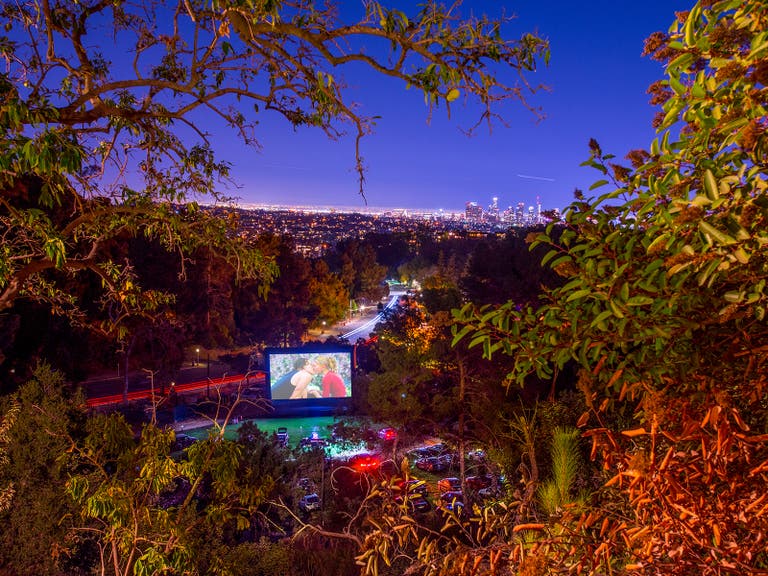Top 10 Must Sees & Hidden Gems of the Space Shuttle Endeavour
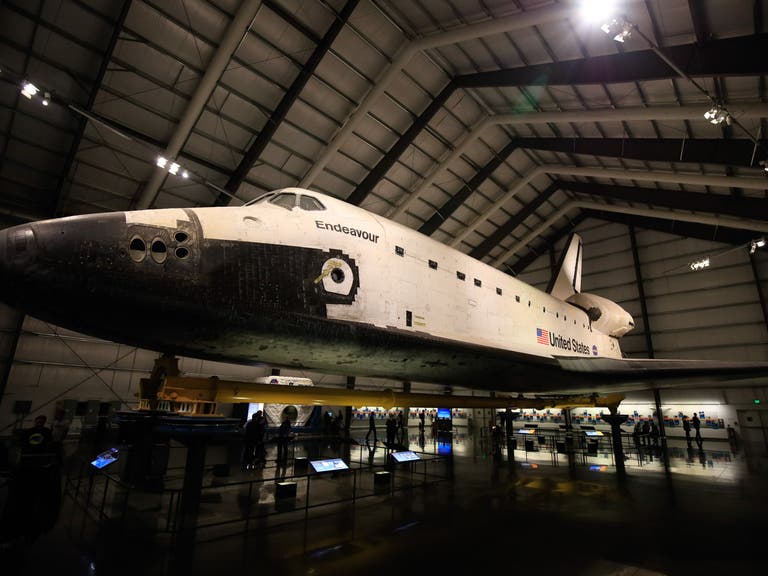
NASA's Space Shuttle program, officially called the Space Transportation System (STS), was the U.S. government's manned launch vehicle program from 1981 to 2011. The Space Shuttle is the only winged manned spacecraft to have achieved orbit and land, and the only reusable space vehicle that has ever made multiple flights into orbit. Officially designated as Orbiter Vehicle-105, the Space Shuttle Endeavour was the fifth and final orbiter to be built. In April 2011, NASA announced that the California Science Center would receive the Endeavour, one of four orbiters to go on permanent display at the conclusion of the Space Shuttle program.
On October 30, 2012, the Science Center became the permanent home of the Endeavour, which landed at Los Angeles International Airport (LAX) in September 2012. After an extraordinary journey through the streets of LA, the Endeavour went on public display in the Samuel Oschin Space Shuttle Endeavour Display Pavilion. “Endeavour belongs to all of us and was part of a fleet of vehicles that defined America’s human space exploration for the past 30 years," said Kenneth E. Phillips, Ph.D, the Science Center’s Curator for Aerospace Science. "It represents the best that we can do as human beings when we choose to work together.”
Visiting the Endeavour requires a timed ticket, which only costs $3. Another ticket option includes the Endeavour plus an IMAX movie screening.
To help you make the most of your visit, Dr. Phillips shares his thoughts on ten must sees and hidden gems of the Space Shuttle Endeavour.
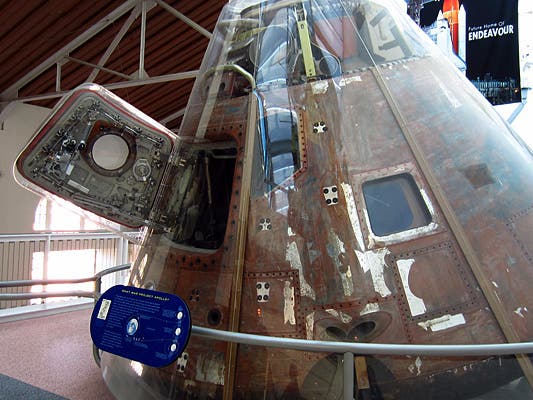
1. NASA SPACE CAPSULES
Before you begin your Endeavour experience, don’t miss the remarkable trio of NASA space capsules in the Air and Space Gallery, on loan from the National Air and Space Museum, Smithsonian Institution. “The Science Center is one of the only museums in the entire country to feature flown space capsules from all three pre-shuttle programs, including Mercury, Gemini and Apollo,” said Dr. Phillips. In 1961, the Mercury-Redstone 2 capsule took a chimpanzee named Ham into space in preparation for a human launch. The center's Gemini 11 was flown into space by Pete Conrad and Dick Gordon in September 1966. The Apollo capsule on display is the actual Apollo-Soyuz Command Module that docked with Russia's Soyuz spacecraft in July 1975.
ENDEAVOUR: THE CALIFORNIA STORY
The Space Shuttle experience begins with Endeavour: The California Story, a companion exhibit that celebrates Endeavour’s many scientific achievements and its strong connection to Southern California, where all the orbiters were built. The California Story includes images of Endeavour under construction locally in Palmdale and Downey, as well as artifacts that flew into space aboard Endeavour.
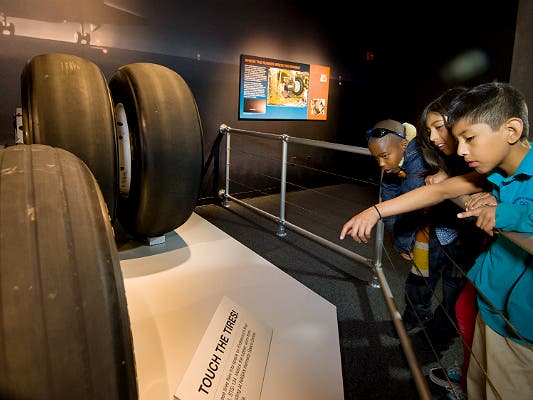
2. Endeavour Tires
At one display, visitors are encouraged to touch the actual tires from Endeavour flight STS-134, which show the wear from its final landing on the runway at the Kennedy Space Center on June 1, 2011. "The large photo behind the tires gives you a hint about why the main landing gear tires are not worn equally,” said Dr. Phillips. “See if you can match what the photo shows to what you actually see on the tires themselves."
Like most aircraft tires, Space Shuttle tires were filled with nitrogen. Shuttle tires had to weather temperature changes from -40 degrees Fahrenheit in space to +130 degrees Fahrenheit on landing in a matter of minutes, as well as a drop in altitude of over 200 miles in less than an hour.
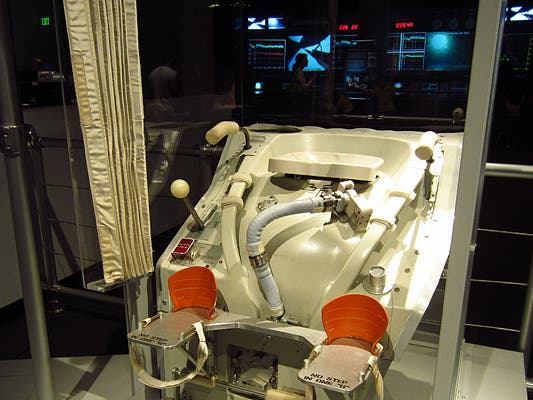
3. Sally Ride Curtain
According to the Science Center, "How do the astronauts go to the bathroom?" is by far the most frequently asked question, posed by children and adults alike. Formally known as the Waste Collection System (or WCS), the "Space Potty" functioned somewhat like a high-tech vacuum cleaner in the microgravity environment on orbit. The Space Potty was located on the Shuttle’s middeck, just behind the crew hatch. At the Space Potty display, look for the "Sally Ride Curtain," a privacy curtain nicknamed for the astronaut who became the first American woman in space as a crew member of the Space Shuttle Challenger in 1983. Dr. Phillips noted, "Apparently not a priority until female astronauts came aboard the Shuttle, the privacy screen ushered in a new era of luxury in low Earth orbit!"
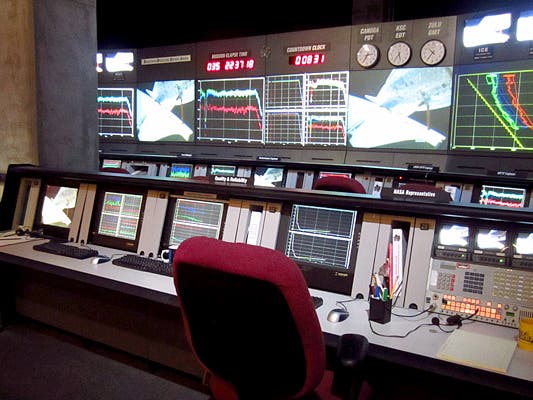
4. Rocketdyne Operations Support Center (ROSC)
Every Space Shuttle launch, from the first to the last, was monitored from Los Angeles at the Rocketdyne Operations Support Center (ROSC). Space Shuttle main engines (SSMEs) for the orbiters were originally built by Rocketdyne in Canoga Park, located in the San Fernando Valley. Engineers at the ROSC (aka “the rock-sock”) remotely monitored the SSMEs during launch and for the first eight and a half minutes of every shuttle flight, checking pressures, temperatures, and other readouts until the Shuttle reached orbit. If something went wrong, Rocketdyne staff could provide recommendations to launch control in Florida or Mission Control in Houston. Pratt & Whitney Rocketdyne donated the entire ROSC to the California Science Center for display in the California Story exhibit.
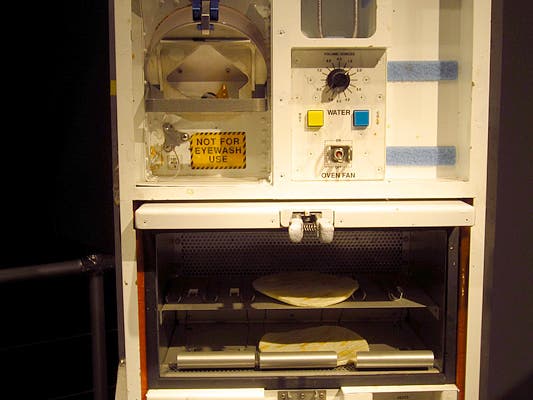
5. Tortillas in the Galley
Astronauts on the Endeavour used a special kitchen, called a galley, to prepare meals in space. The galley is a modular unit that contains a water dispenser and an oven. The water dispenser is used for rehydrating foods, and the galley oven is for warming foods to the proper serving temperature. The galley was installed on the orbiter's mid-deck. The galley on display at the California Science Center is the Shuttle Orbiter Repackaged Galley (SORG), and Endeavour was the first orbiter to use it. Later, all the orbiters were updated to include the SORG. A popular Southern California food item, tortillas, were a favorite of Shuttle astronauts because tortillas don’t generate crumbs. Astronauts used tortillas for everything from burritos to peanut butter and jelly.
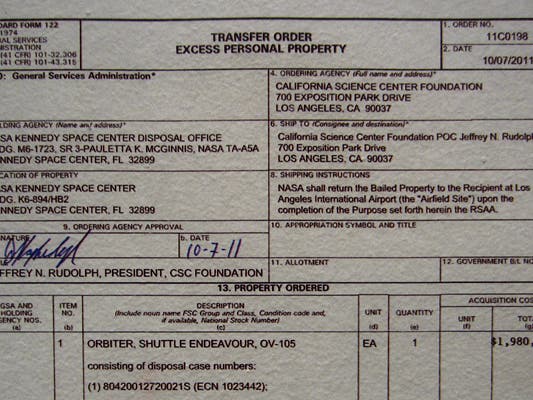
6. Transfer Order
To experience Endeavour missions from an astronaut’s point of view, visitors can purchase a ticket and ride the Pulseworks Shuttle simulator. Discreetly mounted near the Shuttle simulator is the Endeavour transfer order that was signed by Jeffrey Rudolph, President and CEO of the California Science Center and President of the California Science Center Foundation. This unique document is the receipt that said Rudolph was entitled to receive the Endeavour from NASA. Note the value of the orbiter: $1.98 billion.
SAMUEL OSCHIN ENDEAVOUR DISPLAY PAVILION
The Space Shuttle Endeavour first flew in May 1992 on mission STS-49, and its 25th and final mission (STS-134) was in May 2011. Its missions included many firsts, such as the first service mission to the Hubble Space Telescope, as well as the first mission to add a U.S. component to the International Space Station. The Endeavour carried the first African-American female astronaut into space (Mae Jemison), the first Japanese astronaut in the shuttle program (Mamoru Mohri) and the first married couple to fly on the same space mission (Mark Lee and Jan Davis). The Endeavour was also the first (and only) shuttle to be named by elementary and secondary students.
In the Samuel Oschin Endeavour Display Pavilion, guests can view the Endeavour up close and discover some of the science behind this amazing vehicle. The pavilion features images and video that introduces guests to Endeavour’s past missions and the crews who flew them. “In designing the exhibits for the Samuel Oschin Endeavour Display Pavilion, our team tried to anticipate every question that our guests could possibly ask about how the Shuttle operates,” said Dr. Phillips. “We were surprised to discover just how many questions people had about every little detail visible on the orbiter.”
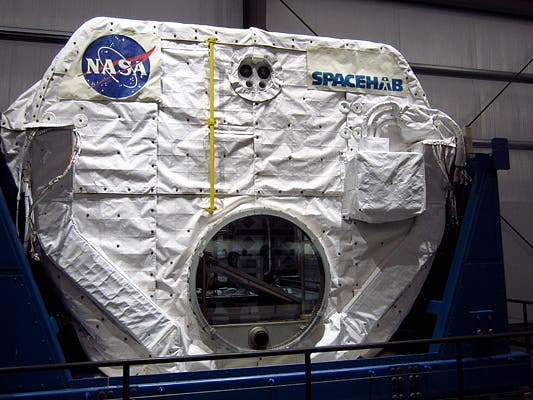
7. SPACEHAB
Serving as a workshop for astronauts, the SPACEHAB Logistics Module gave astronauts extra room to live and work in space. Invented by aerospace engineer and entrepreneur Robert Citron, SPACEHAB was initially conceived as a way for tourists to travel into space aboard the Shuttles. Although NASA didn’t allow SPACEHAB to be used for space tourism, SPACEHAB was the first payload component developed by a private business that humans could occupy in space. A tunnel connected the pressurized SPACEHAB to the orbiter’s crew compartment, so astronauts could reach it—and work inside it—without putting on spacesuits. SPACEHAB modules flew on the shuttle 18 times, and the first and last SPACEHAB missions were flown on Endeavour.
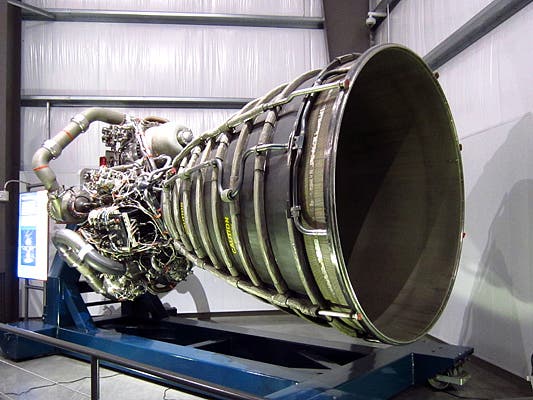
8. Space Shuttle Main Engine (SSME)
Still considered the most advanced, efficient rocket engine in the world, the Space Shuttle Main Engines (SSMEs) worked together with the solid rocket boosters to push the Shuttle from launch pad to orbit. Clustered in a set of three at the back of each orbiter, the SSMEs burned propellants from the large, orange external tank mounted on the orbiter's underside. The three SSMEs propelled the Shuttle with over 1.5 million pounds of thrust. The energy released by the three SSMEs was equal to the output of 13 Hoover Dams.
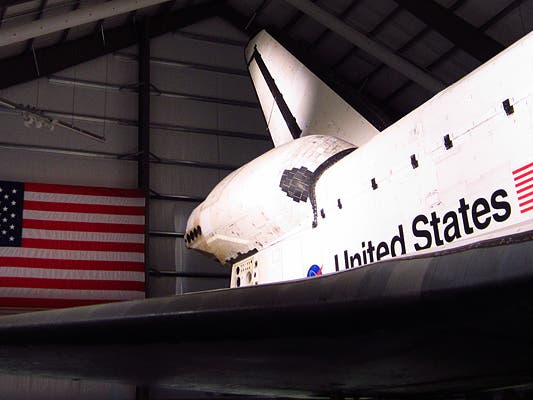
9. "Backwards" U.S. Flag
Sharp-eyed visitors will notice that the U.S. flag on the starboard side of the Endeavour appears to be "backwards." But tradition (and an interpretation of the U.S. Flag Code) suggests that the blue field on the flag should always be pointed forward, into the wind, as if the flag were flying on a flagpole in the breeze. The flag is painted the same way on many aircraft, such as the tail of Air Force One at the Ronald Reagan Presidential Library.
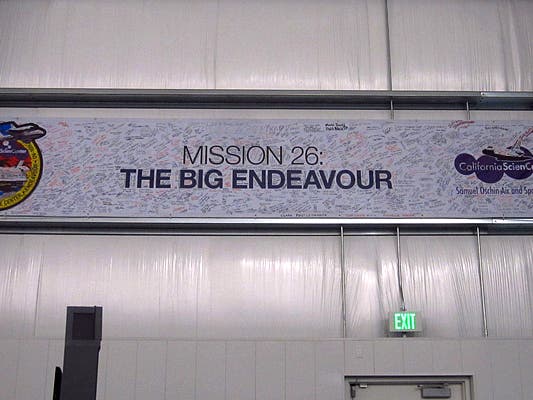
10. Mission 26 Banner
The Endeavour’s journey from the Kennedy Space Center to its new home at the California Science Center was dubbed Mission 26: The Big Endeavour. For its final flight, the Endeavour was mounted on top of NASA’s Boeing 747 Shuttle Carrier Aircraft (SCA). After a cross-country trek to Edwards Air Force Base in the Mojave Desert, the Endeavour made a five-hour loop that took it to Northern California before it entered Los Angeles air space over the Santa Monica Pier.
The Endeavour made low level passes over L.A. landmarks such as the Hollywood Sign, Griffith Observatory, Dodger Stadium, Battleship IOWA, the Queen Mary and Disneyland before it landed at Los Angeles International Airport (LAX) on Sept. 21, 2012. After careful preparations, the Endeavour made an extraordinary, 12-mile trip through the streets of L.A. that began on October 11 and ended at the Science Center on October 14.
Los Angeles-based AAA Flag & Banner created a commemorative "Mission 26" banner in honor of the Endeavour's historic journey. Dr. Phillips said, “The banner includes the names of all people, staff, volunteers, key donors and vendors, who had a hand in getting Endeavour from LAX to the Science Center—simply couldn’t have done it without them!” Dr. Phillips added, "Just as important as the thousands of people who moved Endeavour were the 1.5 million observers and well-wishers who helped us take care of the spacecraft and cheered us along the way." The custom banner and other custom signage printed by AAA Flag & Banner can be viewed in the Samuel Oschin Pavilion. The banner is displayed on the wall opposite the entrance. In addition to flags, decals and banners, AAA Flag & Banner helped create the entrance for the Shuttle simulator, as well as special backlit fabrics for the Shuttle display.
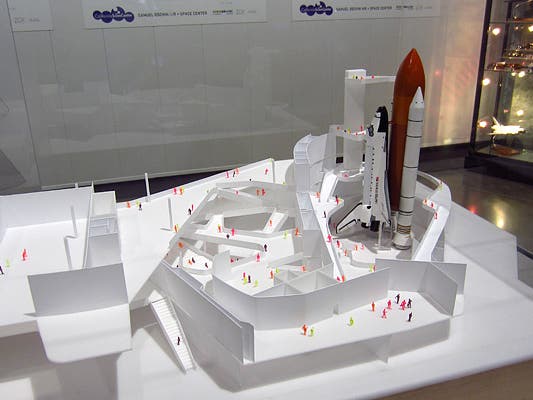
Sneak Peek: Samuel Oschin Air and Space Center
The Samuel Oschin Pavilion is actually a temporary site for the public to view the Endeavour. Inside the pavilion, look for a scale model of the Samuel Oschin Air and Space Center, a spectacular new educational facility with the Endeavour as its centerpiece. Dr. Phillips said, "Don’t think that the Samuel Oschin Air and Space Center will feature only the Space Shuttle Endeavour in launch position. It’ll have aircraft, planetary probes, telescopes and spacecraft from the pre-Shuttle programs as well as displays about the exciting future of space exploration and the origins of the Universe."
